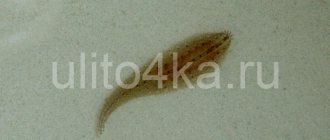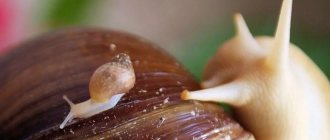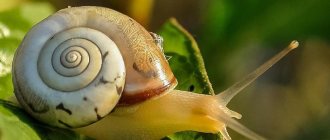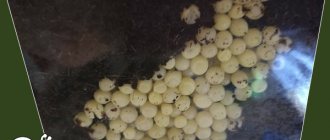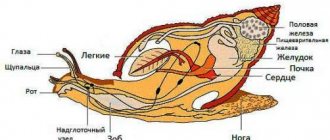Almost every novice snail breeder faces certain problems when caring for their pets. Such problems include a chipped growth, a cracked shell, a pet’s poor appetite, a change in the color of the shell, and much more. Most of these problems can be avoided if you adhere to the rules of care and nutrition. But if something happens to your pet, then immediately try to eliminate the reason that caused the trouble. Today we will talk about the case when the shell of snails turns white, the main reasons for this and how to eliminate them.
Age
Like all living things, snails also age. And the loss of pigmentation is a completely natural process during the aging of a mollusk. In this case, you will not be able to do anything. Representatives of many species of snails, such as immaculates and fulicas, can become almost completely white with age. Very often you can find advice that recommends lubricating the sink with oil or something else. But this does not make sense, since you cannot return the snail to its former color, and after drying the shell will be white again. Just accept it and continue to love your now white snail. But if your pet is still very young, and the shell of the Achatina snail turns white, then look for a different reason.
Improper care
One of the most common reasons when the shell of the Achatina snail turns white is improper living conditions.
So it could be:
- Very low humidity in the terrarium. To increase humidity, spray the walls of your pets' home more often. When moistening the terrarium, do not howl to loosen the soil.
- Soil waterlogging. If you spray frequently, then moisture probably accumulates on the soil, leading to waterlogging. This can happen if the terrarium has many ventilation holes. To fix this problem, you should close several holes and change the filler.
- Inappropriate soil in the terrarium. Whitish spots on the snail shell may appear if you use too alkaline or acidic soil as a filler. In this case, sweep the filler onto coconut substrate, moss, neutralized peat, you can also use the top layer of soil from a deciduous forest or combine these types. You cannot use any store-bought flower soil, sawdust or sand as a filler in a snail terrarium.
- The shell of snails also turns white from swimming under running water, which may contain various impurities and substances. If a white coating on the shell of a mollusk has formed from tap water, then try to remove it with a brush or small washcloth, slightly rubbing the whitened area. In most cases, this plaque will disappear. And in the future, use filtered or boiled water to bathe the snails. After the procedure, you can lubricate the sink with vegetable oil (except sunflower oil), wait until it is absorbed, blot off any remaining oil with a napkin and return it to the terrarium. You can also use an oil solution with Vittri vitamins; just apply it to the sink for 15 minutes a couple of times a week, without affecting the growth area, and then wipe with a napkin. A good diet with plenty of calcium is also necessary. After complete recovery, oil treatments can be canceled.
- Lack of calcium. Review your pet's diet and increase the amount of calcium.
Why is this happening
Due to the fact that there are very few malacologist specialists, and diseases of snails and their treatment have practically not been studied, we can only guess what causes organ prolapse in a snail. Most snail breeders who have encountered this problem have come to the general conclusion that the following factors influence organ prolapse in snails:
- Improper nutrition - eating large amounts of protein foods that do not have time to be overcooked or sour fruits (citrus fruits, pineapple).
- Poisoning from spoiled or low-quality products, or from mold or mildew on them.
- Improper maintenance – too high humidity or irregular cleaning in the snail’s home, which provokes the development of mold, bacteria, fungi and infection.
- Hypothermia during transportation or sudden temperature changes, resulting in decreased muscle tone of the pet.
- Unsuitable soil containing fertilizers or other substances harmful to shellfish, which can cause poisoning. Also, from being kept on sawdust, an inflammatory process and organ prolapse can occur.
- Old age or laying, as a result of which the pet became weak and muscle weakness appeared.
- Parasites that the snail could have contracted from natural sources, from insufficiently treated soil from a summer cottage or moss, snags and branches from the forest.
- Genetic predisposition.
So, let's look at each individual case and describe the sequence of actions.
Gnaws
Another fairly common occurrence is gnawing. The snail gnaws its shell itself or its relatives help it in this. Most often, this happens from a lack of calcium, so pets should increase the amount of calcium supplements. If this does not help and the gnawing continues, observe your pets and identify the culprit. If the snail eats its shell itself, then try sticking a piece of plaster to the gnawed area or applying Vittri ointment, propolis, birch tar or fish oil. If a snail is being chewed by another snail, then remove the culprit. Read more about gnawing in our next articles.
Aquarium snails
Not only the pigmentation of land mollusks changes, but the shells of aquarium snails also turn white. This is observed from a lack of calcium or from soft water with a low pH. Snail shells not only turn white, but also begin to collapse.
First, check the water for acidity and hardness. With low hardness, water may be sour, which indicates a lack of calcium. To increase the level of calcium in the water, it is recommended to add coral or marble chips, shells, chalk or eggshells to the aquarium. But keep in mind that this water is not suitable for all fish. If you do not want to raise the level of calcium in the water, then try feeding the snails. For this, boiled cabbage leaves, slices of fresh cucumber, cottage cheese, special calcium tablets for fish or food for turtles are perfect.
We hope that our article was useful to you, and you now know why the shell of snails turns white. Write comments and share your experience in treating your pets.
It is rare to find a snail breeder in our environment who has not encountered any problems while keeping a snail at home. The most common are slow growth of the mollusk, mechanical damage and discoloration of the shell, fungi and parasites.
Many of these troubles can be avoided by following the basic rules for the care and maintenance of Achatina snails. In this article I want to tell you why a snail’s shell turns white and how to eliminate the causes of the white coating.
Diseases
Snail diseases, diagnosis, first aid. How and with what to treat a snail.
The Achatina snail does not want to eat, what should a snail breeder do?
The African snail is characterized by a good appetite and indiscriminate eating. She likes to crunch on sepia and snack on cucumber and steamed grain mixture. How interesting it is to watch her at this time. What to do if in the morning you... Read more.
Death of the Achatina snail: the main reasons, what to do and how to help it
Hello, my dear. I want to thank everyone for leaving comments and asking questions. A few days ago I received a letter from one of my readers in my inbox. In it, she talks with great love about her snail,... More details.
Prolapse of the stomach and internal organs of the Achatina snail. How to help
Hello, my dear. I decided to continue the topic of Achatina snail diseases. Today we will talk about prolapse of the digestive organs. This is a fairly common disease in Achatina snails. If help is not provided in time, the mollusk will die... Read more.
Problems with a snail shell: White coating on the shell, what to do
It is rare to find a snail breeder in our environment who has not encountered any problems while keeping a snail at home. The most common are slow growth of the mollusk, mechanical damage and discoloration... Read more.
What to do: the snail is gnawing on its shell (shell)
The calling card of the African snail is its shell. It is one of the distinctive features in the species diversity of Achatina. Before selling, many breeders wipe the snail's shell with oil, this makes the mollusk even more... Read more.
What to do if there are ticks in the terrarium: parasites on the Achatina snail
The African snail is a very unpretentious animal, but even it can get sick as a result of infection with nematodes, mold or mites. Mites are a fairly common problem for captive snails. They are practically invisible... Read more.
Problems with a snail shell: the shell is peeling off, what to do
The Achatina snail is considered an unusual pet in our region. Seeing an aquarium, many expect to see fish, frogs, or, in extreme cases, a lizard or snake. How surprised they are to find a large snail there. Beautiful and healthy hive,... Read more.
Diseases of the Achatina snail: worms, mold and fungus
African Achatina snails kept at home are considered sterile, therefore absolutely safe for us and our health. How can one not remember that the Achatina snail is hypoallergenic and is recommended to be kept as... Read more.
Nematodes: how to rid a snail of parasites
Nematodes are round white worms reaching 5 mm in length. They live in moist soil and plants, feeding on the remains of vegetables and fruits. They are not dangerous for humans and adult snails, but they cause irreparable harm to the snail clutch. Nematodes... Read more.
The snail's behavior has changed: what to do?
A few days ago I received a letter in the mail saying that the African snail had become lethargic and inactive. He eats and immediately hides in the sink. It has decreased in size and goes into the sink behind a curl, but the entrance is not... Read more.
Why does a snail's shell turn white?
The beautiful shell of Achatina is not only the pride of the snail, but also the snail host. A white coating on the shell always causes annoyance. Many novice snail keepers wonder why a beautiful colored shell suddenly began to change color to white.
Causes of white plaque on the shell of Achatina
- age;
- chlorinated tap water;
- abrasions;
- poor living conditions;
- mold, fungi;
- gnawing.
Snail age
In Ancient Egypt, the snail was a symbol of eternity, but it, like all living beings on our planet, is characterized by old age. Natural loss of pigmentation is characteristic of old snails. It is worth saying that in captivity, on average, snails live no more than 4 years.
For example, in immaculata and fulica, with age, the brown color of the shell can be completely replaced by white. On the Internet, it is advised to lubricate the shell of a mollusk with natural oil, but as practice shows, you cannot return the former color. We love our gray-haired grandparents, which prevents us from loving an elderly snail with a white shell. If a white coating appears on the shell of a young snail, then the reason is improper care.
Poor and incorrect conditions for keeping the snail
One of the main reasons for the appearance of a white coating on a snail's shell is failure to follow the rules of care and maintenance of the African snail.
High humidity, which often leads to waterlogging of the soil. Proper ventilation in the terrarium, complete replacement of the soil and infrequent spraying will help solve this problem. In the absence of a hygrometer, ordinary moss helps to control the optimal humidity in the terrarium. If the humidity is low, the moss turns yellow and you need to spray the soil; if the moss is green, then the humidity in the terrarium is good.
Wrong soil
Beginner keepers use sawdust as soil. Which leads to injury and suppuration of the delicate body of the snail. Some mollusks die after eating such soil; sawdust also does not hold moisture well and quickly turns sour. Wet sawdust forms a white coating on the snail's shell that cannot be removed. Therefore, use coconut substrate or artificial mats as bedding.
Mold and fungi
Under improper conditions, not only does the snail’s shell turn white, but also the body of the mollusk. Due to unsanitary conditions with poor ventilation and rotting food debris, mold and mildew grow in the terrarium, which affects the body and shell of the snail. From such care, the mollusks die within a few months. If such a misfortune befell your pet, begin treatment. Place the snail in a small container.
Wash the terrarium thoroughly with soda, completely replace the soil, disinfect bowls, drinking bowls, and snags with boiling water. Then start treating the snail. Bathe the snail in chamomile infusion and carefully clean the shell with a toothbrush. Spray the body with reptile pesticide spray. Sink - with propolis ointment.
Watch a video on how to stop the Achatina snail from chewing its shell
Tap water
Our tap water contains various impurities and dangerous chlorine, which harms all living organisms. Therefore, the Ministry of Health does not recommend drinking tap water, but using it only for domestic needs. In video clips you can see snails bathing under a tap, but no one then shows what happens to their shell.
White plaque on the shell of Achatina - causes and methods of combating
White plaque on the carapace (shell) of Achatina is, in fact, a common problem. In most cases, this issue is quickly resolved and does not pose a danger to the snail.
So, let's look at the main reasons for this phenomenon and ways to fight for a beautiful, healthy shell).
Loss of pigmentation in older snails
If earlier the snail’s shell was bright and beautiful, but after a few years the shell became lighter and rougher, not as smooth and glossy as before, then most likely it’s due to the age of the snail.
In older snails, loss of pigmentation may occur and the shell becomes lighter or the color becomes uneven. This is normal and does not mean that the snail is sick. Observe your pet's behavior - if the snail behaves the same as before (does not refuse food, does not produce unhealthy-looking and colored mucus), then do not worry.
However, if the shell turns white in a young snail (up to 5 years), then most likely the reason is different.
Inappropriate soil in the terrarium
It is better not to experiment with different types of soil and use coconut substrate as a soil from the very beginning. It is affordable and easy to find at any pet store. It perfectly maintains humidity in the snail's house and does not rot. My snail is almost 6 years old, and I have never changed the type of soil, since coconut substrate is very convenient - both the snail likes it and I feel comfortable working with it.
But you only need to buy coconut substrate that is specialized for terrariums. Do not buy substrate for flowers, as it may contain mineral additives, which can settle on the snail shell in the form of a white coating.
If such a substrate is used, a whitish shell is the least of the evils. Flower additives can be poisonous to Achatina, even if you have prepared and washed the substrate in advance.
Using unsuitable water
For spraying the terrarium, bathing and drinking, use only drinking water (in bottles or after cleaning with a filter). Do not use tap water for these purposes, as it is often hard and contains excessive amounts of mineral salts and impurities.
Running hard water, when it hits the shell and evaporates, leaves a whitish residue, a coating on the Achatina shell (remember the situation with a kettle, if you boil untreated tap water in it).
This plaque is not so easy to wash off. And such water is not good for the health of the snail.
But there is no need to go to the other extreme - do not use distilled water, since it is dead water and is not suitable for drinking.
The ideal option is softened and filtered water, bottled artesian water, or at least boiled water.
It is poor quality water that is the main cause of the whitish coating on the snail’s shell.
By the way, if the water is too hard, then whitish marks will also remain on the walls of the terrarium after spraying as the water evaporates. This is an additional signal that you are using poor quality water.
Presence of abrasive and hard objects in the terrarium
Scuff marks may form on the snail's shell if there are hard objects in the terrarium. For example, stones. When moving, a snail can rub its shell against a hard object and scratches and whitish abrasions will form on it.
Remove hard objects from the terrarium for safety reasons as well. The snail may fall onto a hard object and break the shell.
Snail with clean healthy shell
Other reasons
To correctly identify the cause of the appearance of white plaque on the shell, you need to exclude all of the above factors.
- you have a young snail;
- you use special soil for terrariums and process it correctly before placing it in the container;
- use clean water and there are no dangerous objects in the terrarium,
but there is plaque on the sink, perhaps there is some kind of disease.
First of all, you should make sure that you have chosen the right food for the snail and that the mollusk has calcium in constant access. Shell defects are often due to a lack of calcium in the snail's body.
How to remove whitish plaque from the shell of Achatina
Once a month I wipe the snail's shell with a cotton pad moistened with clean water.
If there is plaque, you can use a soft brush or sponge. There is no need to scrub the sink with abrasive sponges, as scratches will form on the sink into which dirt will get trapped.
After cleaning the shell with a brush and clean water, you can lubricate the sink with refined oil, but only a little, literally a drop. Only for final polishing. After this, the plaque should completely go away. If the plaque remains a little, it will gradually come off with subsequent care of the sink.
Under no circumstances use citric acid, soda, or chemicals to remove white plaque. This can lead to the death of the pet. A snail shell and scale in a kettle still require a different approach.
Most often, a white coating on the shell of Achatina is not something serious or dangerous, but is a signal that some mistakes were made in caring for the pet. Therefore, pay attention to this and keep your snails healthy.
What to pay attention to
African giant Achatinas do not die like aquarium fish, turning over with their belly up. They can struggle for a long time to exist without showing external visible signs.
Unfavorable maintenance factors can cause the snail to not crawl out of its shell. If they are not corrected, this can cause the death of Achatina.
How the last representative of a valuable snail species died - read on.
First of all, these are low temperatures, a lack of vital elements in the diet and the general malaise of Achatina. Perhaps a sick snail is not sick or dying, but simply stressed! She reacts negatively to changes in environment and other unfavorable factors; she needs adaptation and restoration of vitality. In this case, the Achatina will close its lid and burrow into the ground and can remain in this state for 1-2 weeks. These are alarming signs that can lead to the death of Achatina.
We recommend purchasing high-quality terrariums, as well as soil, heating, humidifiers and decor on the Aliexpress website. This is proven quality and good prices.
How to understand that the Achatina snail is dying?
Only daily close observation of Achatina will provide accurate and reliable information. Every day in the evening, breeders renew the food supply, pour water into the drinking bowl and watch the slow-moving creatures in the terrarium.
A dying Achatina snail does not eat, drink, or respond to external stimuli. If an individual does not move for 2-3 days, does not react to the owner and to fresh food, then the pet has big problems and perhaps they can lead to his death.
Signs of death of the Achatina snail:
- The shell is sealed with film for a long time and the pet shows no signs of life.
- When Achatina is torn from the surface or touched, it instinctively retracts its head and leg. A weakened individual, close to death, does not exhibit characteristic natural reflexes.
- The main sign of death is that the dead Achatina snail has become sealed and stinks. If the sink smells like a rotten egg, this indicates the death of a defenseless pet.
Russian and foreign breeders of African mollusks have already accumulated extensive experience in the proper care and rescue of Achatina snails. It is important to keep a close eye on the delicate creatures and take preventative measures as needed. Let's look at the main mistakes.
Prolapse of internal organs from the throat
Since it is not known for certain what exactly fell out, we can assume that these are the digestive organs. Most often the stomach falls out. In this case, you need to act quickly and decisively, since the vital activity of the mollusk is disrupted. The causes may be an infection or an inflammatory process.
Before handling your pet, wash your hands thoroughly or use gloves.
First, it is necessary to relieve inflammation. To do this, dilute Miramistin or chlorhexidine with water in a ratio of 1/1. Pour it into a bowl and place the sick snail in it. Bathing lasts about 10 minutes.
Next, you need to puncture the bubble with liquid. To do this, heat the needle, wait until it cools down, and pierce the radular sac in the place where the greatest accumulation of fluid is. To make the liquid flow out better, lift the snail. Puncture of the bladder will not solve the cause, and without the necessary treatment, the prolapse may recur. If fluid appears in the prolapsed organ again, the puncture must be repeated.
After these manipulations, treat the punctured organs with Miramistin solution. To do this, use a fresh solution, not the one you bathed in.
After this, dissolve 1 Metronidazole tablet (250 mg) in a glass of warm water and pour into a bowl. Place the snail there and bathe it for 10-15 minutes.
Place the clam in a separate container on a clean, damp towel, which you have previously poured over with boiling water.
Observe your pet for an hour. If the snail does not retract the organs on its own, then you will have to help it. This can be done with a damp finger or an ear stick soaked in water.
After the organs return to their place, leave the mollusk in a separate container for another day, changing the towel every 3-4 hours. Or use disposable paper towels, but don't let the snail eat them. Maintain humidity inside the snail container.
Continue treatment with metronidazole. The course of treatment should be 7 days. But reduce the dosage to 0.5 tablets per glass.
There is no longer a need to treat organs with miramistin after realignment.
For about two weeks after the shedding, feed the snail neutral foods - pumpkin, zucchini, apple and lettuce.
The last few years have seen a significant increase in the number of snails suffering from organ prolapse. To protect your pets from such a scourge, we advise you to promptly clean your pets’ terrariums, prevent them from hypothermia, feed them with approved foods, and use only well-processed materials as filler for snails. Share your experience and leave your comments. Read about prolapse of the genital organ in a snail in our next article.
Common Breeder Mistakes
Why can the Achatina snail die? Inexperienced owners themselves do not understand that by wrong actions they have caused irreparable harm to their Achatina. A few common mistakes made by breeders:
- African babies are often given to children and they love to hold them. To do this, they pull the Achatina by the shell and tear it off the surface, but this is absolutely not the way to treat the snail’s fragile legs. The muscle that holds the shell is injured by the traction, and the snail may lose its protective shell. And without a shell, the snail dies.
- If the terrariums are left without lids, then the snails strive to escape into the wild. Due to oversight by breeders, large Achatina crawl out of the container and fall onto hard surfaces. In this case, they are likely to risk damage to the shell, which is why the Achatina snail often dies. A caring owner can save a pet by treating the damaged shell and strengthening the snail’s diet with calcium-containing foods.
- Inexperienced breeders can drown their pet while swimming. If the snail is bathed under a tap, then you should not expose the snail’s head to a strong stream of water; Achatina may choke and die.
- The delicate bodies of African Achatina are very sensitive to temperatures. From direct sunlight or the proximity of heating radiators, delicate creatures can cook, and from low temperatures in the container, from drafts from the window, they can go into hibernation and not wake up.
- A few grains of salt accidentally falling into a terrarium can kill an entire family of snails. Children unknowingly feed their pets bread, sausage, and pickles; this is a common cause of death for the Achatina snail.
- Inexperienced breeders add oranges and tangerines to the diet of sensitive African girls. Please note that citrus fruits can be given to shellfish in limited quantities. Strong acid from natural juices destroys the fragile shells of African beauties - Achatina.
Diseases of gastropods - causes of death of delicate pets
To understand how and why Achatina snails can die, you need to understand the most common snail diseases. Most ailments arise due to the breeder’s oversight and uncomfortable conditions in the uterus.
But it happens that the owner breaks his head, blames himself and is sad about the dead Achatina snail, but it is not the owner’s fault. Achatina may die due to genetic diseases that cannot be cured or prevented.
Sink problems
- The most common cause of snail death is a broken shell. Due to the owner's carelessness, pets fall out of containers and fall onto hard surfaces. The result is cracks of varying sizes, chipped apex, holes in the shell and broken growth. If you take proper measures in time, the snail will most likely die.
- The second common problem is shell delamination. This happens due to poor living conditions or due to a genetic disease. Modifications to the shell occur due to the stressful state of the snail. Perhaps she doesn’t like the soil, isn’t happy with the food, or is depressed by the neighborhood. If the conditions for the mollusk are ideal, but the shell still stands, then this is a genetic disease that will lead to the irreversible death of Achatina.
- White plaque on the shell occurs from constant friction against some objects, due to illiterate maintenance or as a result of aging of the snail. In nature, African Achatina live 7-10 years, but in captivity this figure can be reduced by 2 times. The old snail is turning gray and you can only make it easier for her to die soon.
- Thermal and chemical burns are often found in delicate and defenseless Achatina. Owners do not wash their hands before petting their pets, and a wide variety of harmful substances can remain on the skin: grains of salt, pepper, particles of detergent. There have been cases when owners, while doing housework, cooking or cleaning, can accidentally stroke Achatina out of emotion. Then they are surprised to observe dark spots and unsightly changes on the skin, due to which the pet can also die.
Eating problems
- One of the most common causes of death in domestic Achatina is food poisoning. Owners buy fruits and vegetables in supermarkets and markets, do not wash them well enough, and do not check them for high levels of fertilizers.
- Eating one's own shell or a neighbor's shell is a common occurrence among African Achatina. The main causes of this disease are the pet’s deep stress, lack of calcium or genetic predisposition. In the first cases, you can correct the situation by transplanting the pet and changing the living conditions; in the case of a congenital disease, it is almost impossible to help the animal and it will most likely die.
- The loss of the internal and genital organs of a snail is very frightening for inexperienced breeders, because even a child understands that the snail can die from this. It has been noticed that this phenomenon occurs due to chemical poisoning by drug vapors, due to hypothermia or a sudden change in living conditions. Breeders try to set prolapsed organs, but this is not always successful. The adult individual copes with the problem itself and draws in its fallen “spare parts.” But if the situation is not corrected in time, then most likely the sick Achatina will die.
To know exactly why Achatina snails die, you need to constantly expand your knowledge about gentle African beauties. Any creature living under the care of its owner requires close attention and careful care. Knowing the signs of death of Achatina snails is not very pleasant, but necessary for every breeder.



